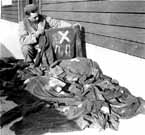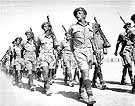
|
|
|

|

|

|

|
|
Click on an image to see a larger, more detailed picture.
|
|
|
|
|
| 1944: Desperate Acts |

|
pg. 576 |

|
|
|
|
| |
 This American GI, among those who liberated the Natzweiler-Struthof camp, inspects the markings on a prisoner's clothing. The letters "NN" stand for Nacht und Nebel (night and fog). The Night and Fog decree, issued by Hitler on December 2, 1941, was intended for use against sabotage organizations and those guilty of espionage. They were to be executed upon capture or, if that did not prove practicable, deported to the Reich for trial. Most such prisoners were first sent to Natzweiler.
This American GI, among those who liberated the Natzweiler-Struthof camp, inspects the markings on a prisoner's clothing. The letters "NN" stand for Nacht und Nebel (night and fog). The Night and Fog decree, issued by Hitler on December 2, 1941, was intended for use against sabotage organizations and those guilty of espionage. They were to be executed upon capture or, if that did not prove practicable, deported to the Reich for trial. Most such prisoners were first sent to Natzweiler.
Photo: National Archives/United States Holocaust Memorial Museum Photo Archive
|
 Still in civilian dress, a group of recruits joins the Jewish Brigade at Meir Park in Tel Aviv, Palestine. Wearing armbands designating them as "volunteers," they seek to join Jewish forces already sent from Palestine a month earlier to fight in the Italian campaign. Some members of the Armée Juive, the Jewish Resistance in France, had already fled across the Pyrenees to Spain the previous year, intent on making their way to Palestine to continue the fight for freedom.
Still in civilian dress, a group of recruits joins the Jewish Brigade at Meir Park in Tel Aviv, Palestine. Wearing armbands designating them as "volunteers," they seek to join Jewish forces already sent from Palestine a month earlier to fight in the Italian campaign. Some members of the Armée Juive, the Jewish Resistance in France, had already fled across the Pyrenees to Spain the previous year, intent on making their way to Palestine to continue the fight for freedom.
Photo: Zionist Archives/United States Holocaust Memorial Museum Photo Archive
|
 The Jewish Brigade
The Jewish Brigade
The Jewish Brigade was a British Army regiment comprised exclusively of Jewish volunteers from Palestine. Officially established in September 1944, the group fought in the Italian Theater of the war and later assisted illegal Jewish-immigration efforts to Palestine. The forerunner of the Jewish Brigade, the Palestine Regiment, was created in August 1942. It consisted of four battalions: three Jewish and one Arab. Pressure exerted by the World Zionist Organization, as well as support from Winston Churchill and Franklin Roosevelt, resulted in the creation of the independent Jewish Brigade. Led by Brigadier Ernest Benjamin, the brigade employed the Zionist flag as its standard. Five thousand Palestinian Jews served in the brigade. The idea of creating a Jewish regiment was initially dismissed by the British for fear of antagonizing the Arab populace in Palestine. Wartime contingencies, however, compelled the British government and military establishment to change their minds.
Photo: Imperial War Museum / United States Holocaust Memorial Museum Photo Archive
|
|

|

|

|

|
 December 17, 1944: Eighty-six American prisoners of war are murdered by SS troops at Malmédy, Belgium.
December 17, 1944: Eighty-six American prisoners of war are murdered by SS troops at Malmédy, Belgium.
|
 Winter 1944: Hundreds of ill and starving Jewish women die slowly in segregated tents at the Stutthof, Germany, concentration camp.
Winter 1944: Hundreds of ill and starving Jewish women die slowly in segregated tents at the Stutthof, Germany, concentration camp.
|
 Winter 1944: In France, a clandestine collaborationist agency, Organisation Technique (Technical Service), is established.
Winter 1944: In France, a clandestine collaborationist agency, Organisation Technique (Technical Service), is established.
|
 December 26, 1944: The Germans' last-ditch offensive of the war, instigated against American troops at Luxembourg's Ardennes Forest on December 16, stalls following ten days of impressive gains. The offensive's ultimate goal, the seizure of Antwerp, Belgium, is not achieved. Nearly a quarter of a million German troops have been killed, wounded, or captured, and more than 1400 German tanks and heavy assault guns have been lost. From this point, Germany's war will be strictly defensive.
December 26, 1944: The Germans' last-ditch offensive of the war, instigated against American troops at Luxembourg's Ardennes Forest on December 16, stalls following ten days of impressive gains. The offensive's ultimate goal, the seizure of Antwerp, Belgium, is not achieved. Nearly a quarter of a million German troops have been killed, wounded, or captured, and more than 1400 German tanks and heavy assault guns have been lost. From this point, Germany's war will be strictly defensive.
|
|
|
|
|
| 1944: Desperate Acts |

|
pg. 576 |

|
|
The Holocaust Chronicle
© 2009 Publications International, Ltd.
|
|
